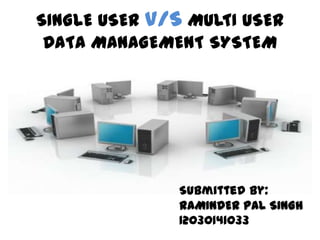
Single User v/s Multi User Databases
- 1. SINGLE USER V/S MULTI USER DATA MANAGEMENT SYSTEM Submitted by: RAMINDER PAL SINGH 12030141033
- 2. INTRODUCTION • Database Management System: A Software Package/System to facilitate the creation and maintenance of database. • Types of Databases : A DBMS can support many different types of databases. Databases can be classified according to the number of users, the database locations, and the expected type and extent of use. The number of users determines whether the database is classified as a single-user or multiuser. Single-user database - supports only one user at a time. If user A is using the database user B or C must wait until user A is through. Desktop database - A single-user database that runs on a personal computer.
- 3. INTRODUCTION Workgroup database - Supports a small number of users (usually fewer than 50) or a specific department within an organization. Enterprise database - Used by an entire organization (usually 100's of users) across many departments. Centralized database - Supports data located at a single site. Distributed database - Supports data distributed across several different sites. Operational database - A database designed to support the companies day-to-day operations. Also referred to as transactional or production database. Data Warehouses - focuses on storing data used to generate information required to make tactical or strategic decisions.
- 4. SINGLE USER DBMS • A single-user can access the database at one point of time. • These types of systems are optimized for a personal desktop experience, not for multiple users of the system at the same time. • All the resources are always available for the user to work. • The architecture implemented is both One or Two tier. • Both the application and physical layer are operated by user. • For Ex: Standalone Personal Computers, Microsoft Access, etc.
- 5. MULTI USER DBMS • Multi user DBMS are the systems that support two or more simultaneous users. All mainframes and minicomputers are multi-user systems, but most personal computers and workstations are not. • A multiuser database may exist on a single machine, such as a mainframe or other powerful computer, or it may be distributed and exist on multiple computers. Multiuser databases are accessible from multiple computers simultaneously • Multiuser databases are accessible from multiple computers simultaneously. Many people can be working together to update information at the same time. All employees have access to the most up-to-date information all of the time. Customers have instant access to their personal information held by companies
- 6. MULTI USER DBMS TELEPROCESSING: Applications One Computer with Programs and DBMS central processing unit N Terminals
- 7. MULTI USER DBMS Workstation 2: Apps Programs FILE-SERVER: and DBMS Workstation 3: Workstation 1: Apps Programs Apps Programs and DBMS and DBMS Network Request for data FILES Returned File Server Database
- 8. MULTI USER DBMS Client 2: Apps Programs CLIENT-SERVER: Client 3: Client 1: Apps Programs Apps Programs Network Request for data DATA Returned SERVER(WITH DBMS) Database
- 9. COMPARISION BETWEEN SINGLE USER AND MULTIPLE USER DATABASE SINGLE USER DBMS MULTIPLE USER DBMS Access Restricted to single user at a Access can share by Multiple user at a time time Database Structure relatively simple Complex Database Structure due to shared access. Complexity Increases with the structure of database Switching between projects is difficult as Switching between projects is easy as different schemas repositories are used single schemas repository is used
- 10. COMPARISION BETWEEN SINGLE USER AND MULTIPLE USER DATABASE SINGLE USER DBMS MULTIPLE USER DBMS Committing change in the database Access sharing makes it difficult to make without causing deadlock changes, sometimes causes deadlock Infrastructure cost is minimum as Infrastructure such as Servers, Networks database is accessed by single user at a are needed for shared access. time Maintenance is also overhead expense Wastage of CPU and resource when Optimum usage/optimization of the user/application remain idle. resources between various users.
- 11. REFERENCES • Fundamentals of Database System, By Navathe. • Database System Concept by Korth. • http://wiki.answers.com • http://www.scibd.com • http://www.gordonschools.aberdeenshire.sch.uk • http://databasemanagement.wikia.com/wiki/DBMS
